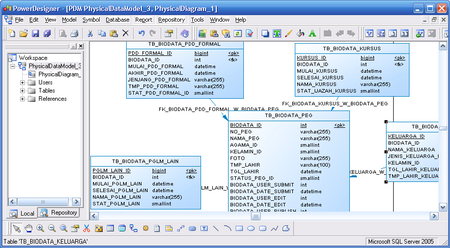

- POWERDESIGNER TUTORIAL HOW TO
- POWERDESIGNER TUTORIAL LICENSE KEY
- POWERDESIGNER TUTORIAL MANUALS
- POWERDESIGNER TUTORIAL INSTALL
- POWERDESIGNER TUTORIAL DRIVERS
This makes sense for any pilot but particularly true for a modelling tool – where the output can be abstract – a smaller scope means it’s easier to show results early. A few ideas I recommend that customers focus on in the pilot include: There is no substitute for a practical experiment to understand where and why PowerDesigner will benefit your efforts.
POWERDESIGNER TUTORIAL MANUALS
A full set of PDF manuals available in PowerDesigner via Help>Online Documentation.If you prefer the self study route there are many resources including: Take a serious look at the Virtual Live Classroom delivery option.

POWERDESIGNER TUTORIAL INSTALL
POWERDESIGNER TUTORIAL DRIVERS
Install a PowerDesigner client system with the ODBC drivers for the repository database.This is often difficult to determine before starting and it is often more practical to simply use a 50 GB database to get started. The installation guide provides a sizing formula based on the size of the models and frequency of update. Whatever database is selected it is important to ensure that the database is correctly licensed and backed up. This can be the SQLAnywhere database supplied with PowerDesigner or MS SQL Server / DB2 / ASE.
POWERDESIGNER TUTORIAL LICENSE KEY
POWERDESIGNER TUTORIAL HOW TO
The process for creating a PowerDesigner key is described in the How to Request License Keys – SAP Sybase document. The Getting Started page provides the instructions for administration of users. Typically the SAP team in many organisations already have these logins it is possible to create additional users if needed. To access the keys on the portal you will need a login (often called an s-user). License keys are obtained via the SAP Support Portal. My reasoning is that it is most effective to install all the server components on one system as part of the initial setup. I suggest doubling this – 4 cores and 8 GB RAM. The minimum recommended system in the manual is a dual-core machine, with 2-4GB of RAM. This simplifies the initial deployment and can be reviewed later if needed.

I recommend using a single Windows based server. As a consequence it pays to initiate the process of obtaining a server early in your PowerDesigner project. In practice a lot of the value of PowerDesigner is associated with having a central repository available and for enterprise deployments this is esstential. Infrastructure Obtaining a ServerĪs PowerDesigner is installed on a desktop sytems this step is often overlooked. This blog outlines four key things needed to get started. Nevertheless the idea of using Power Designer for Enterprise Architecture, Data Modelling or Business Process Modelling was attractive and from there I had a number of discussions on next steps. As a consequence the customers had not investigated PowerDesigner and were unsure of how to get started. In more than one case the customer acquired PowerDesigner as part of a larger solution such a Data Services Enterprise Edition or Intelligent Business Operations. I have engaged with a number of customers recently starting out with PowerDesigner.


 0 kommentar(er)
0 kommentar(er)
